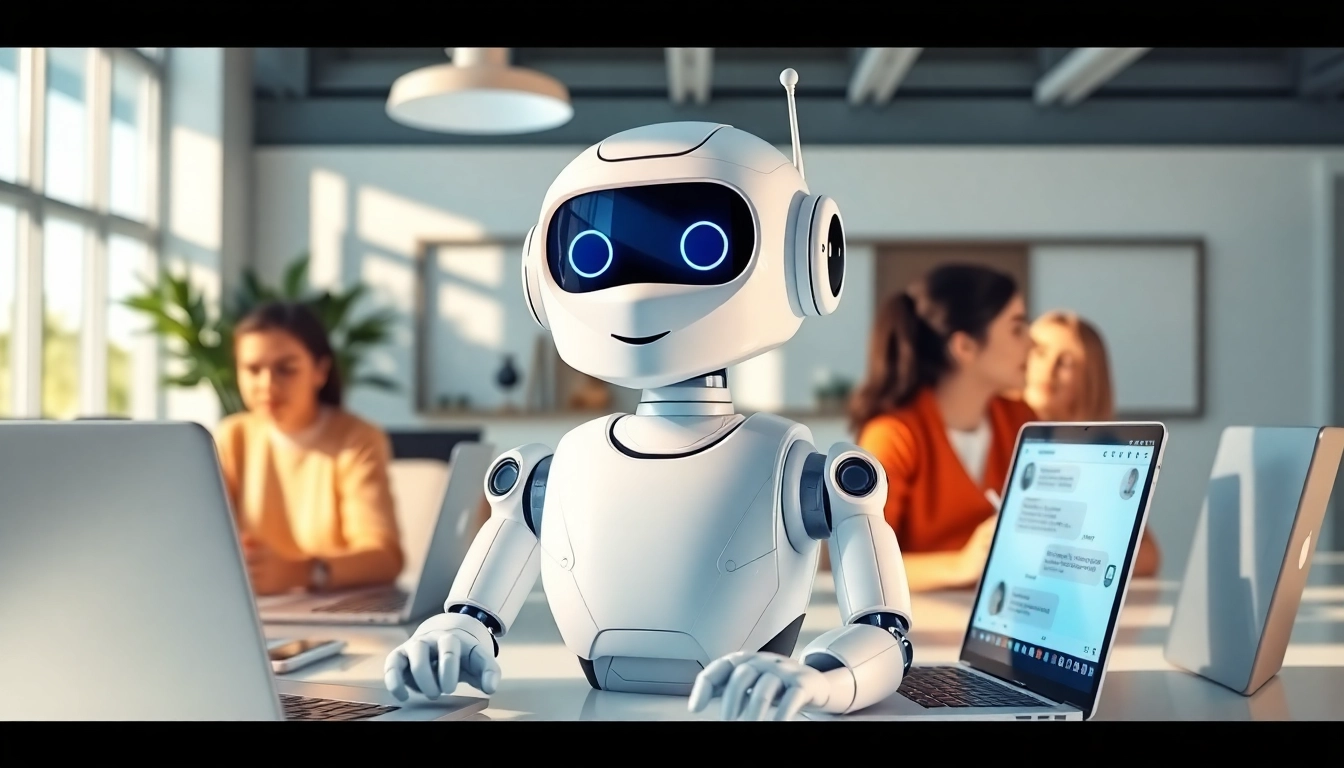Understanding the ChatGPT Chatbot
What is a ChatGPT Chatbot?
A ChatGPT chatbot is an advanced conversational AI application built on the Generative Pre-trained Transformer (GPT) architecture developed by OpenAI. Unlike traditional chatbots that operate on rigid command-based systems, ChatGPT employs deep learning techniques to process natural language, enabling it to understand, generate, and respond to human language in a coherent and contextually relevant manner. This capability makes ChatGPT not just a tool for automated conversations, but a vibrant virtual assistant that can engage with users much like a human would.
By leveraging extensive datasets from the internet, the chatgpt chatbot learns the intricacies of language, making it particularly effective for customer service, interactive storytelling, and personal assistance. The result is a chatbot that can tackle a wide range of inquiries, entertain users, or assist in making decisions across various domains. This versatility represents a significant leap in chatbot technology compared to older systems.
The Evolution of Chatbots in Technology
The journey of chatbots has evolved dramatically since their inception in the 1960s with ELIZA, one of the first programs to simulate conversation. Initially, chatbots relied on predefined rules and scripts, limiting their ability to handle unexpected queries effectively. Over the decades, the integration of machine learning and natural language processing (NLP) has evolved chatbots into more dynamic and responsive agents.
In the early 2000s, pattern-matching methods improved response accuracy, but it was not until the introduction of deep learning algorithms that chatbots began to exhibit significant advancements in understanding context and nuance. Technologies like Long Short-Term Memory (LSTM) and more recently, transformer models, allowed for the processing of longer phrases and maintaining context over multiple exchanges. The development of ChatGPT epitomizes this evolution, with its ability to generate human-like text and adapt its responses based on user interactions, revolutionizing the chatbot landscape.
Key Features of ChatGPT Chatbots
ChatGPT chatbots are distinguished by several key features that set them apart from their predecessors:
- Contextual Understanding: They can maintain context over longer conversations, allowing for more natural and fluid dialogue.
- Natural Language Generation: ChatGPT can produce responses that are not only relevant but sound conversationally correct, enhancing user experience.
- Versatility: They can cater to various applications, including customer service, educational tools, and creative writing.
- Learning Capabilities: ChatGPT can be fine-tuned with specific datasets, enabling customization for different industries or purposes.
Benefits of Using a ChatGPT Chatbot
Improving Customer Engagement
ChatGPT chatbots significantly enhance customer engagement by offering instantaneous interactions and personalized experiences. Users today expect rapid responses, and a ChatGPT chatbot can provide this while simultaneously engaging users with thoughtful, customized recommendations. This level of engagement increases customer satisfaction and fosters brand loyalty.
For example, an online retailer can employ a ChatGPT chatbot to assist users in navigating their products, answering queries about availability, and making suggestions based on user behavior, ultimately leading to an increase in sales conversions.
Automating Customer Support
Integrating a ChatGPT chatbot into customer support systems can streamline operations by handling a significant volume of inquiries simultaneously. This automation frees human agents to tackle more complex issues that require empathy and nuanced understanding, improving overall efficiency. With structured workflows, a ChatGPT chatbot can guide customers through troubleshooting processes, access to FAQs, and product instructions, ensuring a smooth customer journey.
Gathering Valuable User Insights
Beyond conversation management, ChatGPT chatbots can aggregate user interaction data, providing businesses with invaluable insights into customer preferences and pain points. By analyzing chat logs and interaction statistics, businesses can identify trends, understand user needs, and ultimately inform their product development and marketing strategies. Incorporating analytics tools can amplify these benefits, allowing companies to monitor chatbot performance and adapt their responses accordingly.
Implementing ChatGPT Chatbots in Your Business
Choosing the Right Platform
When looking to implement a ChatGPT chatbot, selecting the right platform is crucial. Various options are available in the market, ranging from full-fledged AI service providers to more customizable solutions. Key aspects to consider include:
- Scalability: Choose a platform capable of scaling with your business growth.
- User Experience: Prioritize platforms known for their user-friendly interfaces and seamless integration capabilities.
- Tech Support: Reliable customer support and resources can be invaluable during the deployment phase.
Integration with Existing Tools
To maximize the effectiveness of a ChatGPT chatbot, it should seamlessly integrate with existing business tools and platforms. This might include customer relationship management (CRM) systems, email marketing tools, or e-commerce platforms. Effective integration ensures that the chatbot can access and process pertinent customer data, providing personalized responses while maintaining context across channels.
For example, integrating a chatbot with a CRM could enable it to retrieve past customer interactions, allowing for more informed conversations.
Best Practices for Setup and Deployment
Successful deployment of a ChatGPT chatbot involves adhering to several best practices that ensure its utility and effectiveness:
- Define Goals: Clearly outline the objectives the chatbot aims to achieve, such as improving response time or reducing operational costs.
- User-Centric Design: Create the chatbot’s conversation flow based on user experience, focusing on common queries and feedback.
- Test and Iterate: Conduct thorough testing before full deployment to identify any issues or areas for improvement, continuously refining the chatbot based on user interactions.
Measuring the Success of Your ChatGPT Chatbot
Key Performance Indicators to Track
Evaluating the performance of a ChatGPT chatbot involves tracking specific key performance indicators (KPIs) that reflect its success:
- Response Time: Monitor how quickly the chatbot responds to inquiries and how this impacts user satisfaction.
- Engagement Rates: Track metrics like user retention and interaction rates to gauge the chatbot’s effectiveness in keeping users engaged.
- Conversion Rates: Assess how well the chatbot is driving desired actions, such as sales or sign-ups.
Analyzing User Feedback
Integrating mechanisms for user feedback is critical for continuous improvement. User satisfaction surveys or feedback prompts at the end of interactions can provide direct insights into users’ experiences. Analyzing this feedback can highlight strengths and pinpoint areas where users struggle, guiding further development and fine-tuning.
Iterative Improvements and Updates
Chatbots should not remain static; iterative improvements are essential. Regular updates based on user feedback and performance metrics can help refine conversational abilities and expand the chatbot’s knowledge base. Scheduling routine check-ins to reassess objectives and investigate user needs can significantly enhance the chatbot’s longevity and effectiveness.
Future Trends in ChatGPT Chatbots
Advancements in AI and Machine Learning
The future of ChatGPT chatbots is dictated by continual advancements in AI and machine learning technologies. As these fields advance, we can anticipate that chatbots will become increasingly sophisticated, capable of even deeper contextual understanding. Innovations such as reinforcement learning may allow chatbots to adapt their behavior based on user satisfaction over time, creating more personalized experiences.
Personalization and User-Centric Features
As consumer preferences shift towards personalized experiences, the demand for chatbots that understand individual user contexts will grow. Future ChatGPT bots will likely utilize advanced algorithms to tailor interactions based on previous data, preferences, and behaviors, further enhancing user satisfaction and loyalty.
The Role of Chatbots in Omnichannel Strategies
Chatbots are poised to play a critical role in omnichannel strategies, where seamless interaction across various touchpoints is crucial. Integrating chatbots into mobile apps, social media, and websites can provide users with consistent experiences, regardless of the platform they engage with. ChatGPT chatbots will help unify these interactions by maintaining context across channels, ultimately shaping cohesive customer journeys that boost brand loyalty.


